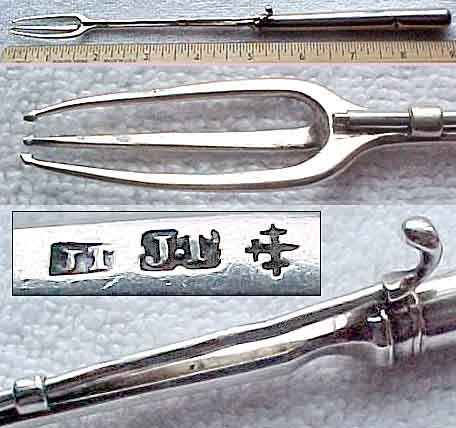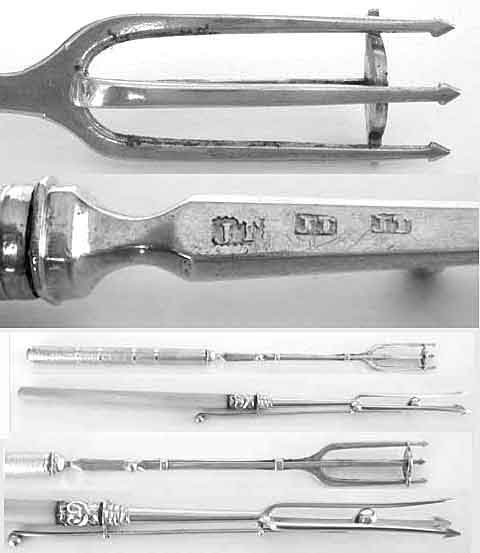|
|
In this Forum we discuss the silver of the United Kingdom, as well as British Colonial silver and Old Sheffield Plate. Past British - Irish Sterling topics/threads worth a look. |
|
|
| How to Post Photos | Want to be a Moderator? |
|
|
In this Forum we discuss the silver of the United Kingdom, as well as British Colonial silver and Old Sheffield Plate. Past British - Irish Sterling topics/threads worth a look. |
|
|
| How to Post Photos | Want to be a Moderator? |

|
 SMP Silver Salon Forums SMP Silver Salon Forums
  British / Irish Sterling British / Irish Sterling
  A mystery fork with mystery marks A mystery fork with mystery marks
|
| next newest topic | next oldest topic |
| Author | Topic: A mystery fork with mystery marks |
|
Brent Posts: 1507 |
  
 This item has me stumped. It appears to be some sort of olive or pickle fork with a sliding "pusher". However, the only pieces of that type that I have seen were Victorian or later. I would place this as late 18th-early 19th C. The patina is consistent over the entire surface, and I am convinced that it is not a fake or made-up piece. The marks are as shown; two different JT stamps and a cross. I am guessing that it has an English or colonial origin; it might be continental. Does anyone have a clue as to the origin of this item? Is there such a thing as a Georgian pickle fork? Brent [This message has been edited by Brent (edited 03-17-2004).] IP: Logged |
|
swarter Moderator Posts: 2920 |
  
Brent - since no one else has responded, I will throw out some observations which may stimulate discussion ("Fools rush in . . . ."). I have no idea of the origin or age of this object, but I doubt it to be English - perhaps, in the boader sense, British (provincial/colonial). For what it is worth, I noticed that two very similar (drawn) marks appear, perhaps only coincidently, on p.655 of Jackson III, in the list of Dublin goldsmiths. There are no dates given, but the larger [J•T] mark is before 1813, and the smaller [JT] is after that date. The larger mark is unascribed, and smaller one attributed to one John Townsend (that the Irish section of this edition has not been revised from the earlier edition). I do not recognize the symbol impressed beside the marks, either - it may be a house mark or a tally mark. It does not appear in Jackson's appended list of symbols nor in Rosenberg's tables; as you suggest, it might imply a continental origin. I am curious to know if the outer tines were originally straight and have been bent inwards - can you tell by running your fingers along them if there is any uneveness that might indicate reshaping? IP: Logged |
|
wev Moderator Posts: 4132 |
  
I have nothing to add to its origin or maker, but might it be a medical instrument of some kind? IP: Logged |
|
Brent Posts: 1507 |
  
Thank you both for your input. I am sure that Swarter is correct, that there is a piece missing from the end of the pusher. Also, I would not be surprised it it were of Irish origin. The tines appear to have been constructed to curve inward. The idea that it might be a scientific or medical instrument of some kind, rather than a dining implement, is intriguing. We know there were specialist scientific instrument makers in the 18th C. It may be that this is one of those obsolete medical devices that is difficult to pin down without some knowledge of medical practices of the time. Brent IP: Logged |
|
swarter Moderator Posts: 2920 |
  
I had an anatomist colleague of mine look at the picture, and he assures me that it is not a medical instrument. He is interested in antiques, as well, and has seen nothing like it. He also said no (modern) medical instrument is ever marked in such a fashion, as the impressions would trap germs. However, it strikes me that few are made of silver, and if this predates the germ theory, it could be. I have finally located my book on antique medical instruments (a real chamber of horrors, that). The only things that approach this are bullet extractors from the late 18th and early 19th Centuries (through the Civil War era). I am guessing here, but if the missing part could have been pushed down to expand the curved tines so that they could pass around a bullet, the hooks would then grip when the rod was withdrawn, and the bullet could then be withdrawn from the wound. Of course, it could also grab an olive or one of those little round onions the same way. . . . IP: Logged |
|
swarter Moderator Posts: 2920 |
  
Perhaps some of those who have joined us in the two years since this one was first posted have something to contribute here. IP: Logged |
|
Brent Posts: 1507 |
  
An acquaintance of mine recently purchased an American sterling long fork with similar in-curved tines, made by Henry Hebbard in his IVY pattern. This acquaintance also collects English silver. When he showed it to some English silver-collecting friends, they pegged it as a pickled egg fork. The curved tines serve to keep the heavy and delicate egg on the fork; straight tines would let it fall right off. I would wager that this mystery fork is also for extracting pickled eggs from a jar. At the very least, it is the best guess I have heard. Brent IP: Logged |
|
DB Posts: 252 |
  
Brent, your fork is definitely a pickle fork and definitely British, BUT it should look like this.  Your fork misses the "push-off" part, I catalogued my fork years ago as London 1840 by John Teare, smallworker, reg.1828, Grimwade 1855, Grimwade states that between 1840-42 other marks with serrated and lobed punches were noticed. The mark next to the JT mark is most probably a journeyman's mark - used to count (and pay for) the output of a journeyman.
IP: Logged |
|
tmockait Posts: 963 |
  
Well the mystery seems to be solved, but I was going to add something about "predating the germ theory." Doctors do not seem have considered the concept of sterlizing instruments until around the middle of the 19th century until Joseph Lister (who gave his name to "Listerine") proposed the idea. So instrument makers would probably not have worried about trapping germs when they designed intsruments. Tom IP: Logged |
|
DB Posts: 252 |
  
Plus, silver has all these antibacterial properties - that's why not only medical instruments but also many kitchen utensils were made from silver. Queen ElizabethI had only silver saucepans and pots, early toasting forks, bottles - the list is endless. ------------------ IP: Logged |
|
Brent Posts: 1507 |
  
Thank you, Dorothea, for clearing up another mystery! Brent IP: Logged |
All times are ET | next newest topic | next oldest topic |
  |
|
Ultimate Bulletin Board 5.46a
|
1. Public Silver Forums (open Free membership) - anyone with a valid e-mail address may register. Once you have received your Silver Salon Forum password, and then if you abide by the Silver Salon Forum Guidelines, you may start a thread or post a reply in the New Members' Forum. New Members who show a continued willingness to participate, to completely read and abide by the Guidelines will be allowed to post to the Member Public Forums. 2. Private Silver Salon Forums (invitational or $ donation membership) - The Private Silver Salon Forums require registration and special authorization to view, search, start a thread or to post a reply. Special authorization can be obtained in one of several ways: by Invitation; Annual $ Donation; or via Special Limited Membership. For more details click here (under development). 3. Administrative/Special Private Forums (special membership required) - These forums are reserved for special subjects or administrative discussion. These forums are not open to the public and require special authorization to view or post. |
|
copyright © 1993 - 2022
SM Publications
All Rights Reserved. Legal & Privacy Notices |